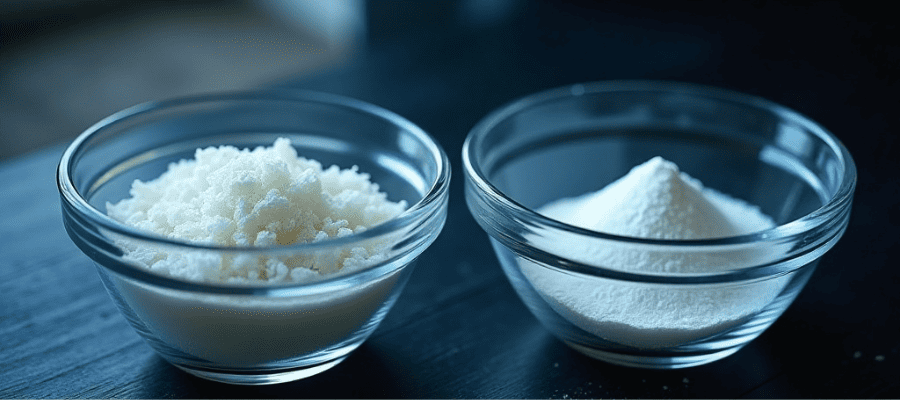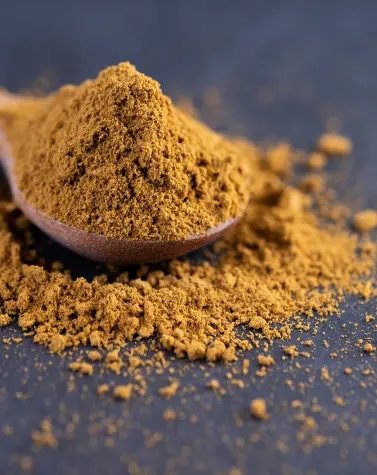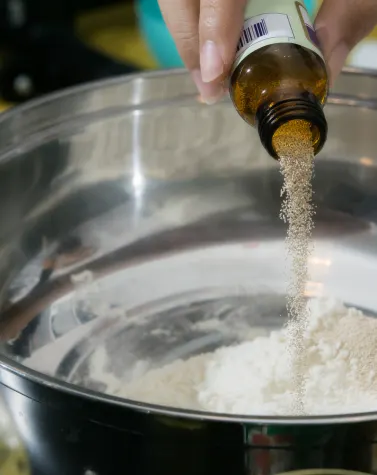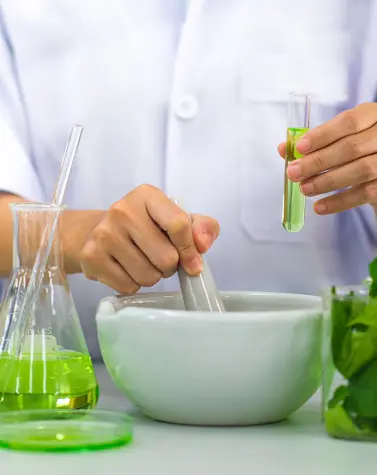
Guar Gum Vs Xanthan Gum: Similarities & Differences
Hydrocolloids are widely used ingredients in various industries such as food, science, manufacturing, pharmaceuticals, textiles, cosmetics and more. They are also a main ingredient in mining, oil drilling and fracking sectors. This article explores the origins, production processes, similarities, variances and applications of these two versatile hydrocolloids.
Xanthan Gum vs Guar Gum – Two of the Most Popular Gums
These two are natural polysaccharides with unique characteristics that when mixed with water, create gels that thicken, stabilize, emulsify and texturize a wide array of products.
Let’s explore the science behind their functionality and major difference between these two hydrocolloids to help you understand which is the perfect choice for your needs.

What is Guar Gum?
Guar gum is a versatile and multifaceted ingredient derived from the seed of the guar plant (Cyamopsis tetragonoloba). This gel-forming dietary fiber has been utilized for decades across various applications, including gluten-free baking, pharmaceuticals and personal care. It comes from the guar beans (cluster bean) and is a soluble fiber like psyllium husk. This annual legume grows in the arid climates of India, Pakistan, Australia, and Africa.
India is the major producer of this gum worldwide, accounting for 80% of production. Traditionally used as a fodder or vegetable crop, guar was discovered in the 1950s for its large-scale industrial applications and commercial viability.
What is Xanthan Gum?
Xanthan gum is a polysaccharide produced not by plants directly but by microbial fermentation of glucose or sucrose. Bacterium Xanthomonas campestris, through its metabolic processes, excretes xanthan gum as a viscous extracellular polysaccharide—essentially, a protective slime layer. This makes xanthan gum a biotechnology product, offering unique functionalities highly valued in various industries. It’s a common edible additive, widely recognized as safe, and used primarily as a thickening agent, stabilizer, and emulsifier.
Is guar gum and xanthan gum the same?
These two gums have their set of similarities but they are far from the same. They are distinct substances due to different chemical structures, origins, and features.
Similarities & Differences Between Xanthan Gum and Guar Gum
| Parameters | Xanthan Gum | Guar Gum |
| Origin | Bacterial fermentation (Xanthomonas campestris) | guar plant (Cyamopsis tetragonoloba) |
| Chemical Structure | Polysaccharide (heteropolysaccharide) | Polysaccharide (galactomannan) |
| Primary Function | Thickening, stabilizing, suspending | Thickening, stabilizing, emulsifying, suspending |
| Thickening Power | High
(effective at low concentrations) |
High
(requires slightly higher concentrations) |
| Temperature Stability | Excellent
(stable over a wide range) |
Good
(less stable at high temperatures) |
| pH Stability | Excellent
(stable over a wide range) |
Good
(best in slightly acidic conditions) |
| Solubility | Soluble in cold and hot water | Soluble in cold and hot water |
| Price | More Expensive | Less Expensive |
| Digestive Effects | May cause gas or bloating in some individuals | May cause gas or bloating in some individuals |
| Allergens | Potential for corn or soy allergens (depending on source) | Generally considered low-allergen |
Xanthan gum originates from bacterial fermentation and provides smooth, stable thickening across varied conditions. In contrast, guar gum, which comes from plant seeds, offers cost-effective thickening and emulsifying but has the potential for a gummier texture. Xanthan excels in temperature/pH stability and elasticity while guar is more economical and works well in acidic environments. Both share several similarities, ideal for their use in food products and recipes such as:
- Thickening – Both can increase the viscosity of liquids such as sauces, gluten free flour.
- Stabilizing – They help prevent separation in mixtures.
- Improving Consistency– They provide texture to dishes.
They are commonly used in gluten-free baking, sauces, dressings, and beverages. Both also find applications in other industries such as pharmaceuticals and cosmetics.
Properties of Guar Gum vs Xanthan Gum
Guar gum is a reliable thickener, smoothly creating viscous solutions, even in cool water—perfect for adding body to sauces or beverages. Its stabilizing qualities prevent ingredients separation and emulsifying and suspending characteristics provide texture consistency. On the other hand, Xantham gum is a thickener with applications in food (subsititute for wheat, gluten free, dairy free cooking and baking muffins, breads), cosmetics and drilling muds.
Stable across a wide temperature range, Xanthan gum is a thickening and suspending agent, ideal for beverages, pharmaceuticals and paints. Guar gum offers versatile texture control and Xanthan gum ensures consistent viscosity and stability. Their differing origins dictate their properties: guar gum for gentle thickening, xanthan gum for robust stability and suspension.
Production Process of Guar Gum
Guar gum goes from a raw material from Indian tree, guar (a bean like plant) and is processed and made ready for commercial use by going through seed cleaning, de-husking and de-germing, milling and grinding, screening and grading and finally, packaging and storage. First, guar seeds are harvested from mature pods and cleaned to remove impurities like dirt and plant debris. Then, the husk and inner germ are removed through milling, isolating the endosperms (solid particles) containing the gum.
The endosperm (called “guar splits”) is milled and ground into a fine powdery substance. The powder is then passed through screens to separate particle sizes, resulting in distinct gum powder grades with various viscosities. The final powder is now formed and packaged in appropriate containers to be stored in a dry, cool place to be used in various industries.
Sunita Hydrocolloids Pvt Ltd (SHPL) is a leading manufacturer and exporter of guar gum that ensures the highest quality throughout its production. We begin with carefully selected gaur seeds sourced responsibly and meeting our stringent quality standards.
Production Process Of Xanthan Gum
The production of xanthan gum is a carefully controlled bioprocess. It begins with selecting a suitable carbohydrate source, typically glucose or sucrose derived from corn or soy. This sugar is dissolved in water along with essential nutrients for the Xanthomonas campestris bacteria. The bacteria are then introduced into this nutrient-rich solution under carefully controlled conditions, including temperature, pH and oxygen levels. As the bacteria grow and multiply, they ferment the sugar and produce xanthan gum, thickening the solution.
Once the fermentation is complete, the viscous broth containing xanthan gum undergoes several purification steps to help separate the xanthan gum from the other components of the fermentation mixture. This provides us with dried xanthan gum that is ground into a fine powder and ready for use.
Is guar gum and xanthan gum bad for you?
Both gums are generally recognized as safe by regulatory bodies. However, some individuals may experience digestive issues like gas or bloating, especially with excessive consumption. It’s always best to consume them in moderation.
Applications of Guar Gum vs Xanthan Gum
Guar gum uses in food industry is one of the main benefits of guar gum. It is used in ice creams for stabilizing and preventing ice crystal formation, baked goods for gluten free baking or cooking, in recipes for improving texture and shelf life. The gluten free recipes often include this gum. It is also used for thickening and stabilizing sauces and acts as a good dietary fiber supplement.
On the other hand, Xanthan Gum is also used in gluten-free baking and for thickening salad dressings, sauces and pet food. These two food gums are also used to make cat food smooth. However, xanthan gum in cat food is known to cause digestive issues. So, pet owners avoid picking labels that mention xanthan gum in cats’ packaged meals.
In general, guar gum is good for cold foods such as ice cream or pastry fillings, while in guar gum vs xanthan gum ice cream battle, the former wins, xanthan gum makes a comeback with wide applications in making baked goods. It is also the top choice for yeasted breads.
Guar Gum: The Sunita Hydrocolloids Advantage
Sunita Hydrocolloids is a premier manufacturer and exporter of top-quality guar gum products since 1982. With an outstanding track record of over four decades, we are committed to providing high-quality, reliable products with prompt delivery. Our product range includes Suncol Guar Gum Powder, Sunfeed Guar Splits and Sunfeed Guar Korma. We focus on meeting and exceeding industry standards and cater to the North and South American markets.
Guar Gum SHPL Offers
GUAR GUM SXL-20: Modified hydrocolloid for managing rheological characteristics in food systems.
GUAR GUM SXL-30: Modified version for synergy with Kappa Carrageenan and Xanthan Gum, imparting higher gel strength.
GUAR GUM SXL-40: Provides thickening, freeze-thaw stability, and smooth flow properties when used with Xanthan and Kappa Carrageenan.
Choosing the Right Hydrocolloid
Confused about which to choose – Xanthan gum or guar gum? Well, the industry trends point towards guar gum having the upper hand when it comes to use in food and pharmaceuticals industry. It is more versatile, with its extracts utilized in various industries, such as animal feed, farming, horticulture, cosmetics, pharmaceuticals, petrochemicals, textiles, paper production, mining and construction. It is also a cost-effective thickening agent, while Xanthan gum is generally a little more expensive than guar gum.
Though guar gum’s price has fluctuated over the last few years due to its growing demand in oil drilling applications, it still remains the most efficient and cost-effective thickening agent in the market. It gum also tastes more natural and retains its beanie/earthy flavor, which consumers like more. It has a good shelf life and can maintain its different properties for 12 to 18 months, which can be extended by adding certain preservatives.
Get in touch with us to discuss your specific requirements, request product specifications, or inquire about samples.





